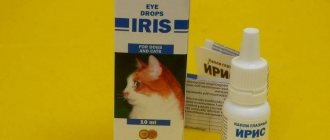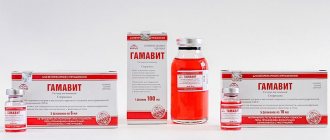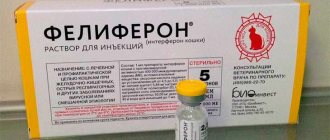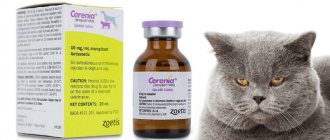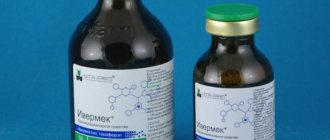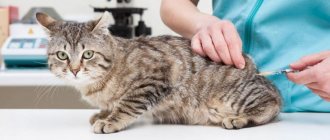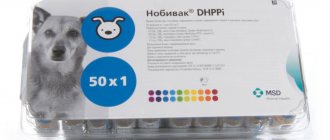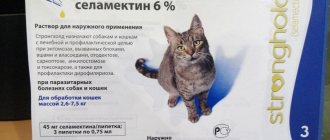Ringer's solution is a very popular veterinary drug that is used if necessary to correct the electrolyte balance of the cat's body. This medicine stops the intoxication and replenishes fluid levels.
Basically, Ringer's solution for cats is used for various conditions of shock, collapse, acute poisoning, peritonitis, ongoing intestinal infections, intestinal obstruction, burns and other painful conditions of the body, which are characterized by large loss of fluid.
Pharmacodynamics and pharmacokinetics
Ringer-Locke solution is capable of regulating the water-salt and acid-base balance in the human and animal body. The product is closest to the natural composition of blood plasma . The drug inhibits the processes of aggregation blood elements and improves tissue perfusion .
Electrolytes thin the blood, and glucose prevents the development of hypoglycemia .
Very quickly after injection, the drug is distributed to organs and tissues.
Pharmacology
In accordance with the instructions, the drug is able to stop the course of intoxication, restore water and electrolyte balance in case of shock or heavy blood loss.
In addition, Ringer's solution is able to replenish the volume of blood circulating throughout the body.
However, due to the fact that the drug quite quickly enters the space outside the blood vessels, the effect of replenishing blood volume is extremely short-lived, lasting no more than forty minutes. Due to the fact that the blood volume increases and its composition becomes more diluted, the concentration of toxic and poisonous substances significantly decreases, which helps to stop intoxication.
Indications for use
The drug is prescribed:
- during dehydration and severe intoxication of the body due to dysentery , food poisoning, diarrhea and vomiting, El Tor cholera ;
- if dehydration occurs due to circulatory disorders, severe blood loss;
- for burns, frostbite, shock ;
- if inflammation of the peritoneum develops - peritonitis .
Ringer-Locke solution is also used for animals with similar symptoms, albeit in a different dosage.
Composition of Ringer's solution and dosage for animals
The composition of this unique panacea is simple; in addition to water, it contains::
- sodium chloride NaCl 0.9%, common table salt;
- calcium chloride CaCl2, the buyer encounters calcium salt on packages in the form of E509, it is considered a safe food additive;
- sodium bicarbonate, otherwise baking soda, NaHCO3;
- Glucose, a source of easy production of solar energy by the body, is found in fruits and berries.
© shutterstock
The composition of blood plasma is approximately the same, so no cases of overdose have been identified.
Forms of release of the drug:
- in glass bottles, volume either 200 ml or 400 ml;
- in plastic bags for injection 500 ml.
What are the manifestations of intoxication and what causes them?
Intoxication manifests itself in different ways. Vomiting with diarrhea may occur, the animal will lie exhausted, frightening the owner with its dying appearance; in severe cases, blindness may occur or bleeding will begin.
To prevent your pet from crossing the dangerous line, use Ringer's solution for the cat.
A cat can be poisoned by lead compounds, which are present in paints in old houses, for example, in zinc white. Intoxication often occurs from cigarette smoke, from low-quality food made from unknown ingredients.
Interaction
Caution should be used when combining the medicine with certain drugs, such as NSAIDs , estrogens or anabolic steroids .
When combined with cardiac glycosides, the load on the cardiovascular system increases.
Concomitant use with diuretics , angiotensin-converting enzyme or potassium supplements can lead to hyperkalemia .
Instructions for use
In an emergency, subcutaneous administration of the drug is allowed.
If your pet exhibits symptoms of severe poisoning or dehydration, he will need an IV with Ringer-Locke solution. Intravenous drip administration for intoxication with poisons is preferably done in a hospital. If quick help is needed, before going to the clinic you need to inject the medication under the pet’s skin. The instructions for use note that a single dose is 40-50 ml, and a daily dose is 100-150 ml. The kitten's veins are small and compressed, so he is advised to inject the solution subcutaneously. The therapeutic dose is calculated individually based on the weight, age of the animal, and the complexity of the disease.
Limitations and Side Effects
The medication has a composition identical to blood plasma, so no unwanted symptoms are observed in cats after its use. Exceeding the dose causes overhydration or acidosis. In such cases, the administration of the drug is stopped or the dose is reduced. Ringer-Locke solution quickly increases the fluid content, so it is prohibited for pulmonary or cerebral edema. The medication is contraindicated if the kitten or adult pet has the following pathologies:
Kidney problems make it impossible to use the drug in a relatively sick animal.
- kidney dysfunction;
- difficulty passing urine or lack of urination;
- insufficiency of heart function;
- high blood acidity;
- hypovolemia.
How to replace Ringer-Locke solution?
The medicinal liquid can be replaced with analogues if necessary. There is a regular Ringer's solution for cats, but it does not contain glucose, which helps the liver cope with an abundance of toxins. Therefore, this medication is not so effective for poisoning. The following infusion solutions have a similar effect on the cat’s body:
- "Glycosteril";
- "Glyukosol";
- "Neohemodesis";
- "Trisol";
- Ringer's lactate.
If it is not possible to quickly get to the clinic at the first signs of poisoning in your pet, you need to inject yourself in the recommended dosage subcutaneously, but after this the animal should be urgently shown to a veterinarian.
special instructions
The medication does not replace saline; other medications cannot be diluted in it. The salts in the solution react with the components of the medications, changing their properties, which leads to unpredictable consequences for the health and life of the pet. Ringer-Locke solution can be used to wash wounds and mucous membranes of cats. Caution should be given to your pet if he is receiving estrogens or NSAID tablets. When a drug is prescribed in a course, it is necessary to change the injection sites to increase the effectiveness of the treatment.
Analogs
Level 4 ATC code matches: Disol
Sterofundin
Trisol
Ringer's solution
Gik, Glyukosol, Darrow, Glycosteril, Acesol, Yonosteril, Ringer's solution, Disol, Trisol, Chlosol, Saline solution.
Ringer-Locke solution, 100 ml
COMPOUND
The drug contains as active ingredients 0.9 g of sodium chloride, 0.02 g of potassium chloride, 0.02 g of calcium chloride, 0.02 g of sodium bicarbonate, 0.1 g of glucose, and as a solvent - water for injection up to 100 ml.
PHARMACOLOGICAL PROPERTIES
After administration of the drug, it is quickly absorbed from the injection site and distributed in the organs and tissues of the animal.
Ringer-Locke solution contains a balanced (isotonic) mixture of the main cations (Na+, K+, Ca+, Cl-, HCO3-) of the blood in appropriate concentrations and is more physiological compared to 0.9% isotonic sodium chloride solution.
The administration of Ringer-Locke solution restores the water-salt balance and replenishes fluid deficiency in the body that occurs during dehydration or due to the accumulation of extracellular fluid in areas of extensive burns and injuries, abdominal operations, and peritonitis. Ringer-Locke solution reduces the aggregation of formed elements and blood viscosity, improves its rheological properties and tissue perfusion, preventing the development of irreversible changes in tissues and increasing the effectiveness of blood transfusion measures in case of massive blood loss and severe forms of shock.
Ringer-Locke solution also has a detoxification effect by reducing the concentration of toxic products in the blood and activating diuresis.
APPLICATION
Ringer-Locke solution is used in animals for dyspepsia and other diseases accompanied by dehydration and intoxication of the body, blood loss, and for washing wounds and eyes.
Ringer-Locke solution is used subcutaneously or intravenously in the following doses (in ml per animal). When administered subcutaneously, the dose of the drug is administered fractionally to different places.
| Horses, cattle | 1000 – 3000 |
| Small cattle | 100 — 300 |
| Calves up to one year old | 200 — 400 |
| Lambs, piglets | 25 — 100 |
| Dogs | 10-200 |
| Cats | 5-50 |
Doses and timing of use depend on the weight of the animal and the course of the disease.
The use of Ringer-Locke Solution does not exclude the use of other medications.
OVERDOSE
At recommended doses, the drug usually does not cause side effects or complications in animals.
SIDE EFFECTS
The use of Ringer-Locke solution in large quantities can lead to the development of chloride acidosis and overhydration. In case of such complications, the dose is reduced or the drug is discontinued.
CONTRAINDICATIONS
Intravenous administration of Ringer-Locke Solution is contraindicated in cases of severe impairment of renal excretory function.
If the interval between two injections of the drug accidentally increases, it should be administered as quickly as possible.
SPECIAL INSTRUCTIONS
Livestock products during and after the use of Ringer-Locke Solution are used without restrictions.
STORAGE
The solution should be stored in a dry, dark place, out of reach of children, at a temperature from 0°C to 25°C. Shelf life – 2 years.
PACKING
Ringer-Locke Solution is produced in the form of a sterile injection solution, packaged in 100 ml glass bottles, sealed with rubber stoppers reinforced with aluminum caps.
Pregnant, lactating and puppies
Ringer's drug and its derivatives should not be used to treat pregnant dogs. This can negatively affect the course of pregnancy and the development of the babies. Also, veterinarians do not recommend using the drug to help animals that are feeding their offspring.
Puppies weighing about 300 g are given injections of 10-15 ml twice a day subcutaneously into the suprascapular area so as not to get into the muscle (the skin is pulled back, the needle is inserted below the fingers holding the skin).
Contraindications and side effects
The instructions for use of any medicine must be strictly followed so that there are no negative consequences. In addition, it is very important to know in what cases you can and in what cases you cannot give Ringer-Locke. You should also be aware of what side effects this drug may cause.
Let's start with the fact that this medication cannot be used for edema, since then it will stimulate the accumulation of fluid in the tissues. Use is also not permitted in the following cases:
- anuria;
- oliguria;
- renal failure;
- heart failure.
If the drug is given for such diseases, it sometimes leads to death. It also happens that a cat has an individual intolerance to the components of the medicine, so after taking it an allergic reaction may begin.
Among other things, it is recommended to give the drug very carefully in case of acidosis, hypovolemia and other similar pathologies. For example, in the first case, taking Ringer-Locke can lead to a change in the pH of the blood plasma, and in others - to a significant increase. All this can be very harmful to the animal, so before taking any drug you should definitely consult a specialist.
If after the injection the cat develops symptoms such as aggression or, conversely, lethargy, lack of appetite and nausea, then you must immediately show it to the veterinarian so that he can prescribe other medications that will help the sick animal.
Different breeds
Veterinarians prescribe the volume of solution depending on the weight and size of the dog, taking into account not the breed, but the type of disease and its course. The state of the animal itself at the time of providing therapeutic assistance plays a role in this.
In this regard, even the daily norm is a conditional indicator. For small breeds it is a maximum of 100 ml, for large dogs (Great Danes, St. Bernards, etc.), if dehydration is significant - from 300 to 400 ml. There are situations when a higher dose is required.

